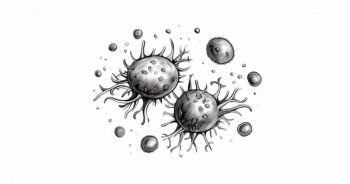
|Videos|December 23, 2019
Rapidly Progressing Acute Myeloid Leukemia
Rapidly Progressing Acute Myeloid Leukemia
Advertisement
Case: A Male With Rapidly Progressing Acute Myeloid Leukemia
A 64-year-old male presented with a 2-week history of subjective fever, fatigue, shortness of breath, dizziness, and cough
H & P
- PE: Temperature 99.1oF, pallor of the conjunctiva, multiple ecchymosis on upper and lower extremities
- PMH: DM controlled on metformin, hypertension, BMI >35, recent history of pneumonia treated with oral antibiotics
- ECOG: 2
Diagnostic Work- Up
- Initial pertinent positive lab values:
- WBC: 2.3 x 103/µL, RBC: 3.1212 x 106/µL, Hb: 9.3 g/dL, Ht: 23.1%, Plt: 83 x 103/µL, LDH: 275 U/L, blasts: 36%, absolute neutrophil count: 320 cells/µL, PT: 16.1s,
- Few auer rods noted on bone marrow aspiration
- Diagnosed with AML with 43% blasts on pathology evaluation, flow-cytometry confirms AML
- Molecular panel and cytogenic testing pending and RUSH requested
- Chest CT revealed patchy consolidation in the left lower lung lobe with ill-defined nodules
- EKG and Echocardiogram unremarkable
- Started on prophylactic voriconazole, cefpodoxime, and valacyclovir
Treatment
- Patient was started at this time on azacitidine and venetoclax; Azacitidine 75mg/m2Days 1-7 and Venetoclax Days 1-28. Venetoclax dose was 100mg with voriconazole.
- Was admitted for tumor lysis monitoring and hydration. Tolerated cycle 1 well. continue until disease progression or unacceptable toxicity
- Day 28 post-treatment bone marrow aspirate revealed low percent residual blasts (3% blasts by flow) with hypocellular BM (5-10% cellularity) and ANC 0.3, platelets 23K
- Venetoclax was interrupted at this time. Labs checked 2-3 times per week outpatient. Within 12 days after venetoclax interruption ANC>0.5 and platelets>50K.
- Cycle 2 started outpatient with standard dose azacitidine and venetoclax reduced to 14-21 days
Follow-up
- Patient subsequently developed pneumonia, treated with oral antibiotics
- Patient will continue routine bone marrow biopsies after cycle 4, and every 6 months thereafter or if disease progression is suspected
Advertisement
Advertisement
Advertisement
Trending on Targeted Oncology - Immunotherapy, Biomarkers, and Cancer Pathways
1
FDA Approves Subcutaneous Amivantamab for EGFR-Mutated NSCLC Indications
2
Enfortumab Vedotin Plus Pembrolizumab Improves Survival in MIBC
3
FDA Grants Regular Approval to Rucaparib for BRCA-Mutated mCRPC
4
Long-Term ECHO Data Support Concurrent Acalabrutinib/BR in MCL
5








































